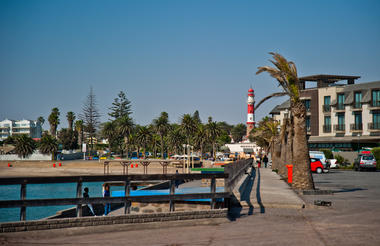With its well-developed infrastructure, some of the best tourist facilities in Africa and an impressive list of breathtaking natural wonders, touring Namibia is truly a pleasure. Visit the capital of Windhoek and the lovely coastal town of Swakopmund to discover remnants of the country’s German influence, reflected in the architecture, culture, cuisine and the annual Oktoberfest celebrations. To properly appreciate this extraordinary country, you will have to venture out of the cities to explore the remarkable natural landscapes Namibia has to offer. These include: the impressive Fish River Canyon Park; the vast Etosha National Park teeming with local subspecies, such as desert lions, desert elephants and the Hartmann's Mountain Zebra; the hauntingly beautiful Kalahari Desert; and of course the Namib Desert stretching for nearly 1000 km along the magnificent Atlantic coastline. Namibia is an ideal destination for travellers seeking an unforgettable African experience in a uniquely beautiful untamed wilderness.
The Kalahari Basin covers most of Botswana and large parts of Namibia and South Africa. The name Kalahari means 'the great thirst' and describes the world’s largest continuous area of sand. It is an exceptionally beautiful semi-desert. In Namibia it is characterised by red dunes, acacia trees and wispy, mostly golden grass. The wide variety of wildlife includes gemsbok, impala, jackal and cheetah, not to forget the famous Meerkat. In all three countries the Kalahari is the last bastion of the indigenous San people who lived as hunter-gatherers in the whole of southern Africa before the modern world started to take over.


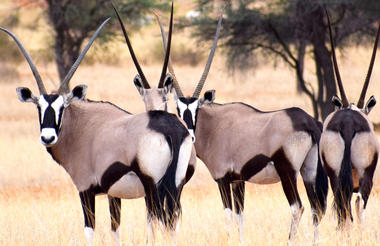
The Fish River Canyon is the most impressive natural wonder in southern Namibia. The canyon starts near Seeheim in the lower reaches of the Fish River and ends 160 km further south at Ai-Ais. It is an awe-inspiring gorge that meanders through the fissured Koubis massif at a depth of up to 550 metres. The Fish River Canyon is the second largest canyon in the world.
The canyon started to form about 500 million years ago during a pluvial episode – i.e. a period of intense rainfall. The huge gorge was not only created by water erosion, however, but also by the collapse of the valley bottom due to tectonic movement and by glaciation during the Karoo Ice Age.
The Fish River Canyon is part of the Ai-Ais/Richtersveld Transfrontier Park. The entrance gate is at the Hobas Campsite, from where it is 10 kilometres to the canyon and the most stunning view of the famous Hell's Bend.
The 86 km Fish River Canyon hike is very popular. But it is a tough challenge of 4-6 days and aspiring hikers have to prove their physical fitness with a medical certificate when they apply for a permit from Namibia Wildlife Resorts in Windhoek. Due to soaring temperatures during the summer months, the trail is open only from May to September.
Much easier, but no less scenically beautiful hikes are offered in the adjacent private nature reserves Canyon Nature Park and Gondwana Canyon Park, which also have excellent accommodation.



Tucked away in the rocky Aus Mountains on the fringe of the Namib plains, the small village of Aus is located in the south-western ǁKaras Region. The arid surroundings are known for their unique botanical diversity. Aus lends itself as an excellent base from which to explore the area and view the main attraction: the feral horses of the Namib Desert, which run wild and free on the sparsely vegetated plains. Catch a glimpse of these desert-adapted creatures at the water trough at Garub just 20 km away from the village.
Activities: Experience the Succulent Karoo on a visit to the beautiful Gondwana Sperrgebiet Rand Park, home to the most biodiverse desert in the world; take a scenic hike to discover fascinating indigenous fauna and flora; view the vast desert landscape from the back of a horse; camp under the dazzling Namibian night sky.



The desert town of Solitaire, in the south-western Khomas Region of central Namibia, is like a small oasis. There is not much to do or see in this tiny village, other than stop for refreshments and filling up with petrol. Solitaire boasts the only petrol station, general store and post office between Sossusvlei and Walvis Bay. There is also a small bar and a bakery famous for its apple pie – said to be the best in the country – as well as a luxury lodge, a motel and a campsite.
Activities: Enjoy a scenic sundowner with spectacular views of the Namib Desert; take time for a hike; go biking through unspoilt natural scenery; visit the local cheetah sanctuary.
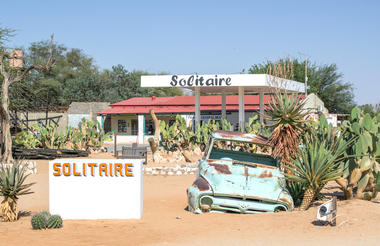
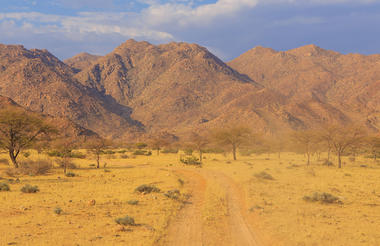
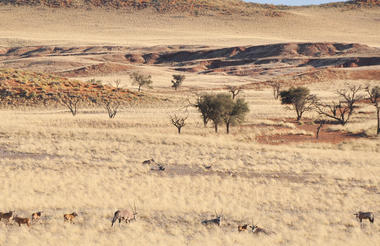
In 1892, eight years after South West Africa was declared a German Protectorate, Swakopmund was founded with the intention to build a harbour. By 1907 a little town pulsating with life had emerged from the desert! Swakopmund boasted the largest European population of all the German colonies in Africa. Decades on and much bigger now, the charming town is as alluring as ever. The mix of Namibian influences with picturesque buildings from the colonial era, palm-lined streets and seaside promenades, the laid-back holiday atmosphere plus the cool sea breeze make Swakopmund one of the most attractive places in the country.
Despite the turquoise waters of the Atlantic Ocean on its doorstep and the Namib Desert as its backyard, Swakopmund is not a tropical sunbathing paradise, however. The moderate climate along the coast is due to the cold Benguela Current. The current also causes the nightly fogs for which the town is famous and which sustain the wealth of desert flora and fauna near the coast. Early mornings and the evenings can be chilly throughout the year – a welcome respite from the inland heat.
Swakopmund has become the country’s adventure mecca. The desert, the dunes and the ocean lend themselves to a host of thrilling activities: sandboarding, sand skiing, quad biking, dune carting, beach angling and deep sea fishing, to name but a few, and not to forget parachuting.
There is no shortage of diverse shops, bistros and restaurants. Small specialist shops sell hand-made leather work, art & crafts, hand-woven carpets and wall hangings, hand-embroidered bed and table linen and other items proudly made in Namibia. Superb jewellery, designed and crafted with local gemstones by master goldsmiths, are another special feature of Swakopmund.
Activities other than fun in the sand and the sea: visit the art galleries and buy contemporary Namibian art and crafts; visit the museum to learn about Swakopmund’s history; join a tour of Karakulia Weavers and watch karakul wool being spun and woven into wall hangings and rugs; admire the world's largest quartz crystal cluster and other mineral treasures at the Kristall Galerie.
